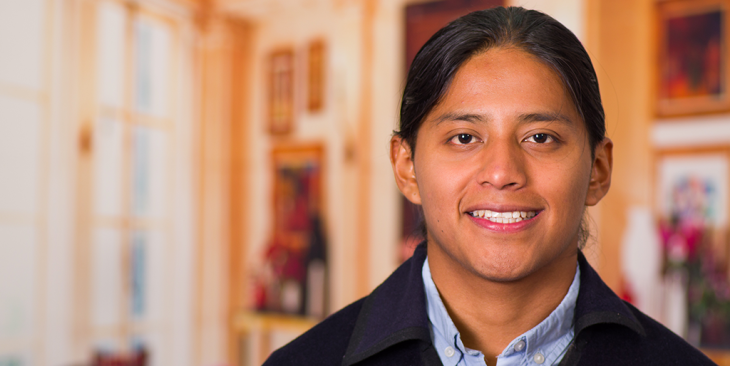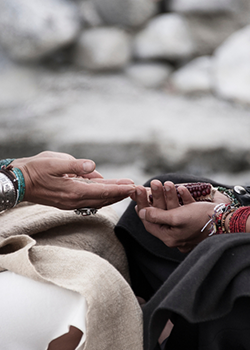
She closed her eyes and stopped her mind from racing. The swirling vibrations were all around, the beating of the drums that mirrored the beating of her heart, and the warm, earthy smoke of the sage that curled over her face.
She took a deep breath in, drawing in the sacred smoke, letting it rest for a beat in her lungs. Then she drew it out with an even longer breath, purifying her body and spirit with the release.
Her mind quieted, letting her connect to her true inner self, the world around her, and all its infinite energies. This is the wisdom that would help her find, and stay on, her path to greater purpose.
People have been using tools like music and smoke to purify bodies and spaces and find spiritual centers for millennia — and for good reason. The rituals can have a profound effect on those who understand their meaning and take the practice to heart.
Ceremonies like this have been particularly important in Native American culture, working as a keystone of spiritual enlightenment for many different tribes. And today, the rituals are increasingly serving a new purpose: helping Native Americans on their journey to sobriety.
What is Culturally Competent Care?
 The idea is called “culturally competent care,” and it’s beginning to take off in the world of rehabilitation.
The idea is called “culturally competent care,” and it’s beginning to take off in the world of rehabilitation.
A branch of the concept of holistic care, which takes the whole of the patient and their circumstances into account when determining treatment plans, culturally competent care puts a person’s cultural beliefs at the center of their rehabilitation experience.
For Native Americans, that could mean incorporating several traditional healing methods into a rehab stay, which could include:
- Drum circles
- Sweat ceremonies
- Smudging
- Vision quests
- Sun dances
- Powwows
- Ceremonial teepee construction
- Art circles
- Purification sweats
These concepts are introduced and utilized alongside more common, clinical aspects of a rehab experience, such as counseling, behavioral therapy, detoxing, and medication administration.
The thought is that, by combining the two approaches, the patient will have a more fulfilling experience, which doesn’t just put them through a cookie-cutter program but speaks to them on a much more profound level.
This could be particularly helpful for the Native American population, who routinely struggle with an outsized rate of substance use disorders. Despite making up just 1.7% of the U.S. population in 2018, nearly 10% of Native Americans reported having a substance use disorder that year, according to the latest numbers provided by the National Survey on Drug Use and Health (NSDUH).
Still, evidence suggests that the meaningful experiences and more relevant recommendations that may come from a culturally competent care facility can help lead to achieving and maintaining sobriety.
How Do Native American Treatment Centers Help
 Indeed, research shows that a patient’s culture — whatever that culture may be — can have a huge impact on their rehab experience.
Indeed, research shows that a patient’s culture — whatever that culture may be — can have a huge impact on their rehab experience.
Described as the shared set of beliefs, values, and norms among any group of people, culture touches on everything from someone’s coping style to their social support, and from any potential stigma attached to substance use to whether the person seeks help at all.
Meanwhile, most treatment professionals share a Western cultural worldview, which carries its own set of expectations about the mind, body, spirit, and science. And the difference between the two perspectives can be detrimental.
Cultural gaps between patients and treatment centers have been linked to barriers to availability and accessibility. One study also found that racial and ethnic minorities were less likely than white patients to receive high-quality care.
Rather than leaving a patient to sink or swim in an unfamiliar environment, culturally competent care flips the arrangement. The onus is on care providers, to ensure their treatment is effective for a diverse range of clients. The idea is so profound, that the concept is clinically referred to as “cultural humility.”
And the concept can help in still other ways.
Working to preserve sacred traditions, in a world increasingly enthralled by technological advances, can help a population of people feel seen, respected, and more deeply connected to their roots. While quantitative research on this front is difficult to conduct, anecdotal evidence has reinforced, many times, the idea of preserving important traditions and rituals as a way of rediscovering identity, and even regaining power.
And this type of back-to-roots approach may be especially meaningful for younger generations of Native Americans, who may not be as familiar with their cultural traditions. Sadly, this group is also the most at-risk for addiction, with the rate of substance use issues for those aged 18-25 as high as 18%, according to the 2018 survey.
Finding Native American Treatment Centers
Thankfully, as the idea of culturally competent care has taken off, programs have become easier to find.
Several databases and search engines can help point you in the direction of the closest facility, including the government database of Native American treatment centers for substance abuse and mental health, run by the Indian Health Service, Tribal, or Urban Indian Health Program.
But, perhaps even more important than where to seek treatment is the decision to seek treatment at all. The first step is always the hardest but can lead to a lifetime of positive change, bringing in greater health and happiness, in any cultural measure of the words.
If you or someone you love is experiencing a substance use disorder, help is available. Call
800-681-1058
(Who Answers?)
today.

